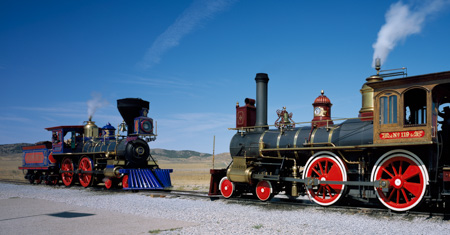Deep disagreement arose over the railroad’s path between the North and South. This log jam was broken in 1861 with the secession of the Southern states that allowed Congress to select a route running through Nebraska to California.
Construction presented a daunting task requiring laying over 2000 miles of track through some the most forbidding landscape on the continent. Tunnels would have to be blasted out of the mountains, rivers bridged and wilderness tamed. Two railroad companies took up the challenge. The Union Pacific began laying track from Omaha to the west while the Central Pacific headed east from Sacramento. Progress was slow initially, but the pace quickened with the end of the Civil War. Finally the two sets of railroad tracks were joined and the continent united with elaborate ceremony at Promontory, Utah on May 10, 1869. The impact was immediate and dramatic. Travel time between America’s east and west coasts was reduced from months to less than a week.



